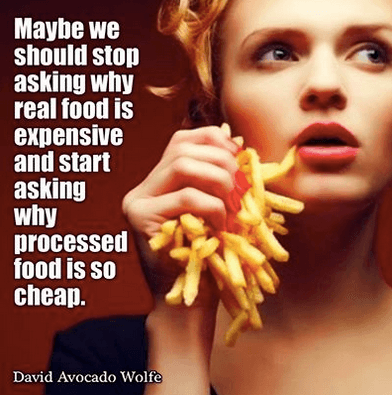Increasing the amount of high quality fat, including saturated fat, in your diet may be the best thing you can do for your health. It’s time to put aside the low-fat diet schemes that have dominated the diet industry for over 40 years.
Sound, scientific research supports the reasonable consumption of healthy fats, including saturated fat, as part of a healthy lifestyle. This article takes a brief look at how we lost our way, what science now says about dietary fats, and which foods may be safely added to our diets.
In 1977 the USDA, through the National Advisory Committee on Nutritional Education (NACNE), recommended that Americans:
1 – Reduce total dietary fat to 30%
2 – Reduce saturated fat to 10% of total calories.
These recommendations were made without scientific, randomized controlled trials ( RCTs) being performed to test their validity before being implemented. Furthermore, there were only five randomized trials of unhealthy men (no women) available to the committee at the time. The committee was also heavily influenced by the now controversial and partially discredited Seven Countries Study of Ancel Keys which implicated saturated fat in cardiovascular disease.
Significantly, the rise in obesity corresponds with the publication of the government’s dietary standards:

A recent meta-review of the 1977 recommendations appeared in the prestigious British Medical Journal’s and put them to rest. The authors, Harcombe, et al, concluded:
- “It seems incomprehensible that dietary recommendations were introduced to 220 million US and 56 million UK citizens given the contrary results from a small number of unhealthy men.”
- “The results of the present meta-analysis support the hypothesis that the available RCTs did not support the introduction of dietary fat recommendations in order to reduce CHD risk or related mortality.”
- And that the dietary recommendations “should not have been introduced.”
Implementing these dietary measures has been devastating. According to the CDC: “Between 1980 and 2000, obesity rates doubled among adults. About 60 million adults, or 30% of the adult population, are now obese.” Obesity rates continue to soar with Type 2 diabetes now at epidemic proportions.
What Does Current Nutrition Science Say About Saturated Fat?
Much of current research paints a very different picture of the role of saturated fat in our diets. Let’s look briefly at four major studies that represent current thinking about dietary fat and specifically saturated fat.
Study 1 – The first study is a retrospective look at a trial completed in the early 1970s, the data from which had been lost. Dr. Christopher E. Ramden led an Australian and US team to evaluate “recovered data from the Sydney Diet Heart Study, a single blinded, parallel group, randomized controlled trial conducted in 1966-73; and an updated meta-analysis including these previously missing data.” The original study attempted to evaluate the effectiveness of replacing saturated fat with omega 6 linoleic acid, a vegetable oil. Participants included 458 men aged 30-59 who had experienced a recent coronary event.
Conclusion: “In this cohort, substituting dietary linoleic acid in place of saturated fats increased the rates of death from all causes, coronary heart disease, and cardiovascular disease. An updated meta-analysis of linoleic acid intervention trials showed no evidence of cardiovascular benefit.”
Study 2 – In 2010 a meta-analysis of 21 prospective studies evaluated the association of saturated fat and cardiovascular disease. The results were published in the American Journal of Clinical Nutrition and led by Patty W Siri-Tarino of the Children’s Hospital Oakland Research Institute.
Conclusion: “A meta-analysis of prospective epidemiologic studies showed that there is no significant evidence for concluding that dietary saturated fat is associated with an increased risk of CHD or CVD.” In other words, there is no verifiable link between eating saturated fat and the occurrence of coronary heart disease.
Cambridge scholar, Dr. Chowdhury, and an international research team in 2014, evaluated nearly 80 studies, including 27 randomized controlled trials (RCTs, the gold standard of scientific research) that involved half a million people. The research included not only what people reported they ate but measured the composition of fatty acids in their blood and fatty tissues.
Conclusion: The researchers found that “…current evidence does not support guidelines which restrict the consumption of saturated fats in order to prevent heart disease.” According to the NY Times: “The researchers did find a link between trans fats… and heart disease but ‘they found no evidence of dangers from saturated fat, or benefits from other kinds of fats.'”
Study 4 – In 2014, Dr. Jeff Volek, a professor of Human Sciences at Ohio State University, and his research team, recruited 16 adults, all of whom suffered from metabolic syndrome. Participants were fed diets that changed every three weeks up to 18 weeks. Every three weeks the amount of saturated fat was decreased and the amount of carbohydrates increased, and the amount of palmitoleic acid in the blood was measured. Palmitoleic acid has been linked to obesity, inflammation, insulin resistance, glucose intolerance, type 2 diabetes, heart disease and prostate cancer.
Conclusion: “When looking at palmitoleic acid… the scientists found that it consistently decreased on the high-fat/low-carb diet in all participants. The fatty acid then showed a step-wise increase in concentration in the blood as carbs were progressively added to the diet.”
In other words, as carbohydrates were added to the diet, levels of the deadly palmitoleic acid increased, thus heightening the risk of CVD.
Dr. Volek concluded: “There is widespread misunderstanding about saturated fat… there’s clearly no association of dietary saturated fat and heart disease, yet dietary guidelines continue to advocate restriction of saturated fat.”
What Have We Learned from These Scientific Studies?
- The 1977 dietary recommendations to limit saturated fat were not scientifically valididated
- There is no clear association between saturated fat and heart disease
- Trans fats (found in processed meats and foods, and vegetable oils) are linked to increased cardiovascular disease
- High fat/low carbohydrate diets lower dangerous levels of palmitoleic acid, which is associated with heart disease and other chronic diseases
- High levels of Omega 6 fatty acids in the form of linoleic vegetable oil showed no positive cardiovascular benefit.
What High-Fat Foods Should We Be Eating?
The following foods, some high in saturated fat, are healthy to consume as part of a natural, whole foods diet:
Avocado, tahini, dark chocolate, eggs, fatty fish, nuts, coconut, and liver. When combined with low carbohydrate foods, (spinach, broccoli, cauliflower, carrots, and others) coconut and olive oil, fresh fruits in moderation, and meat (preferably grass fed organic), a wholesome and healthy diet that guards against heart and other chronic diseases can be attained. Keep in mind that calories do count. It behooves us to eat reasonable portions as well as reduce carbohydrate levels in our diets. It’s both what we eat and how much we eat that matters.
*These foods are recommended given we are all driven towards various diet types and making healthier choices in each diet type is a step in the right direction.
A complete meal plan based on low carbohydrate and healthy fat intake can be found at Authority Nutrition.
Deciding on a diet best for you should be done with an awareness of current scientific thinking and in consultation with your physician or health provider. One diet does not fit all. The best diet for each of us is one that meets our individual needs.
The information in this article is not meant as medical advice and should be used for educational purposes only.
Try Out These 3 Powerful Guided Meditations

These meditations are great for feeling peace and calm. They will also help you overcome any challenges you might be facing.
These meditations can be viewed online and downloaded so you can use them whenever you like. They combine traditional meditation with tapping for a very powerful experience.
They will also help release deep core issues that you may be dealing with as it uses techniques from The Tapping Solution by Nick Ortner.
Check out these free meditations to help bring peace, calm and relaxation.










